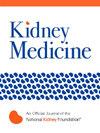Associations Between Lymphopenia and the Development/Recovery of Acute Kidney Injury Among Patients Hospitalized With Respiratory Virus Infections
IF 3.4
Q1 UROLOGY & NEPHROLOGY
引用次数: 0
Abstract
Rationale & Objective
Lymphopenia may have a potential mechanism on the development of acute kidney injury (AKI) after respiratory virus infection but has never been revealed. We aimed to investigate the relationship between lymphopenia and AKI in patients hospitalized with respiratory virus infections.
Study & Design
A single-center and retrospective cohort study.
Setting & Participants
Data were retrospectively collected from electronic medical records of patients hospitalized with severe acute respiratory syndrome coronavirus 2 (SARS-CoV-2), influenza, or other respiratory virus infections from 2016- 2023.
Exposure
Prolonged lymphopenia (<1.1 × 109/L) was defined as continuous lymphopenia lasting for ≥1 day before AKI diagnosis. Serial measurements of serum creatinine levels and lymphocyte counts before AKI were collected.
Outcomes
AKI developed after infection was identified according to the KDIGO guideline.
Analytical Approach
Multivariable logistic regression models and Cox proportional regression models were conducted to evaluate associations between lymphopenia or blood count ratios and AKI.
Results
A total of 3,104 patients were analyzed, including 1,945 infected with SARS-CoV-2, 597 with influenza, and 472 with other respiratory virus infections. The AKI incidences were 18.0%, 23.3%, and 16.3%, respectively. Serum creatinine level was significantly negatively correlated with lymphocyte count in SARS-CoV-2 and influenza infections. Multivariable regression showed lymphopenia, especially prolonged lymphopenia, was significantly associated with AKI in all virus groups, especially in influenza. The risk magnitudes of monocyte-to-lymphocyte ratio, neutrophil-to-lymphocyte ratio, and platelet-to-lymphocyte ratio on admission for AKI varied by different viral infections. Lymphopenia or not was not associated with AKI stages or AKI recovery.
Limitations
The results were limited by the retrospective, single-center setting and the probability of underestimation of the prevalence of both lymphopenia and AKI.
Conclusions
Lymphopenia, especially prolonged lymphopenia, and neutrophil-to-lymphocyte ratio on admission were risk factors for AKI after respiratory virus infection, with the highest risk observed in patients with influenza.
Plain-Language Summary
Lymphopenia may play a role in acute kidney injury (AKI) after respiratory virus infections, but this link has not been well studied. Our research explored the relationship between lymphopenia and AKI in hospitalized patients with COVID-19, influenza, and other respiratory viruses. By reviewing medical records from 2016-2023, we found that prolonged lymphopenia was significantly associated with AKI, particularly in influenza cases. Blood count ratios also varied in their risk for AKI depending on the virus. These findings highlight the importance of monitoring immune cell levels in viral infections. Although our study offers new insights, its single-center and retrospective design may limit broader application. Future research is needed to confirm these results and explore potential interventions.
呼吸道病毒感染住院患者急性肾损伤发生/恢复与淋巴细胞减少的关系
目的淋巴细胞减少可能在呼吸道病毒感染后急性肾损伤(AKI)的发生发展中具有潜在的机制,但尚未被揭示。我们旨在探讨呼吸道病毒感染住院患者淋巴细胞减少与AKI之间的关系。研究设计:单中心回顾性队列研究。背景和参与者回顾性收集2016- 2023年因严重急性呼吸综合征冠状病毒2 (SARS-CoV-2)、流感或其他呼吸道病毒感染住院患者的电子病历。延长性淋巴细胞减少(<1.1 × 109/L)定义为AKI诊断前持续淋巴细胞减少≥1天。收集AKI前的一系列血清肌酐水平和淋巴细胞计数。结果:根据KDIGO指南确定感染后发生aki。分析方法采用多变量logistic回归模型和Cox比例回归模型来评估淋巴细胞减少或血细胞计数比率与AKI之间的关系。结果共分析3104例患者,其中SARS-CoV-2感染1945例,流感感染597例,其他呼吸道病毒感染472例。AKI发生率分别为18.0%、23.3%和16.3%。SARS-CoV-2和流感感染患者血清肌酐水平与淋巴细胞计数呈显著负相关。多变量回归显示,在所有病毒组中,尤其是流感病毒组中,淋巴细胞减少,特别是延长的淋巴细胞减少与AKI显著相关。AKI入院时单核细胞/淋巴细胞比值、中性粒细胞/淋巴细胞比值和血小板/淋巴细胞比值的危险程度因病毒感染的不同而不同。淋巴细胞减少与否与AKI分期或AKI恢复无关。局限性:研究结果受到回顾性、单中心设置和低估淋巴细胞减少症和AKI患病率的可能性的限制。结论入院时淋巴细胞减少,特别是淋巴细胞持续减少和中性粒细胞/淋巴细胞比值是呼吸道病毒感染后AKI发生的危险因素,以流感患者风险最高。淋巴细胞减少可能在呼吸道病毒感染后的急性肾损伤(AKI)中起作用,但这种联系尚未得到很好的研究。我们的研究探讨了COVID-19、流感和其他呼吸道病毒住院患者淋巴细胞减少与AKI之间的关系。通过回顾2016-2023年的医疗记录,我们发现延长的淋巴细胞减少与AKI显著相关,特别是在流感病例中。血液计数比率也因病毒的不同而有AKI的风险。这些发现强调了在病毒感染中监测免疫细胞水平的重要性。虽然我们的研究提供了新的见解,但其单中心和回顾性设计可能限制了更广泛的应用。未来的研究需要证实这些结果并探索潜在的干预措施。
本文章由计算机程序翻译,如有差异,请以英文原文为准。
求助全文
约1分钟内获得全文
求助全文

 求助内容:
求助内容: 应助结果提醒方式:
应助结果提醒方式:


